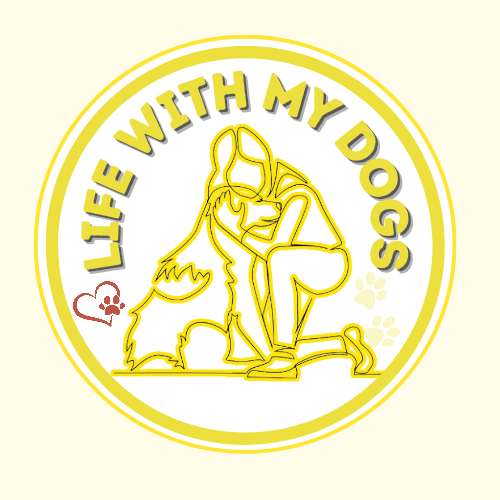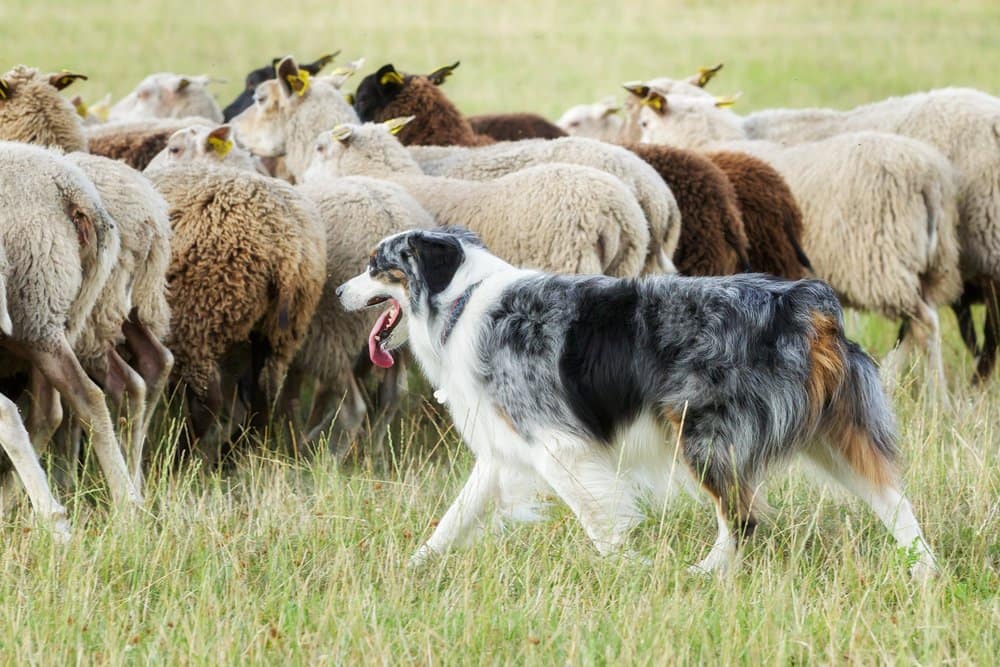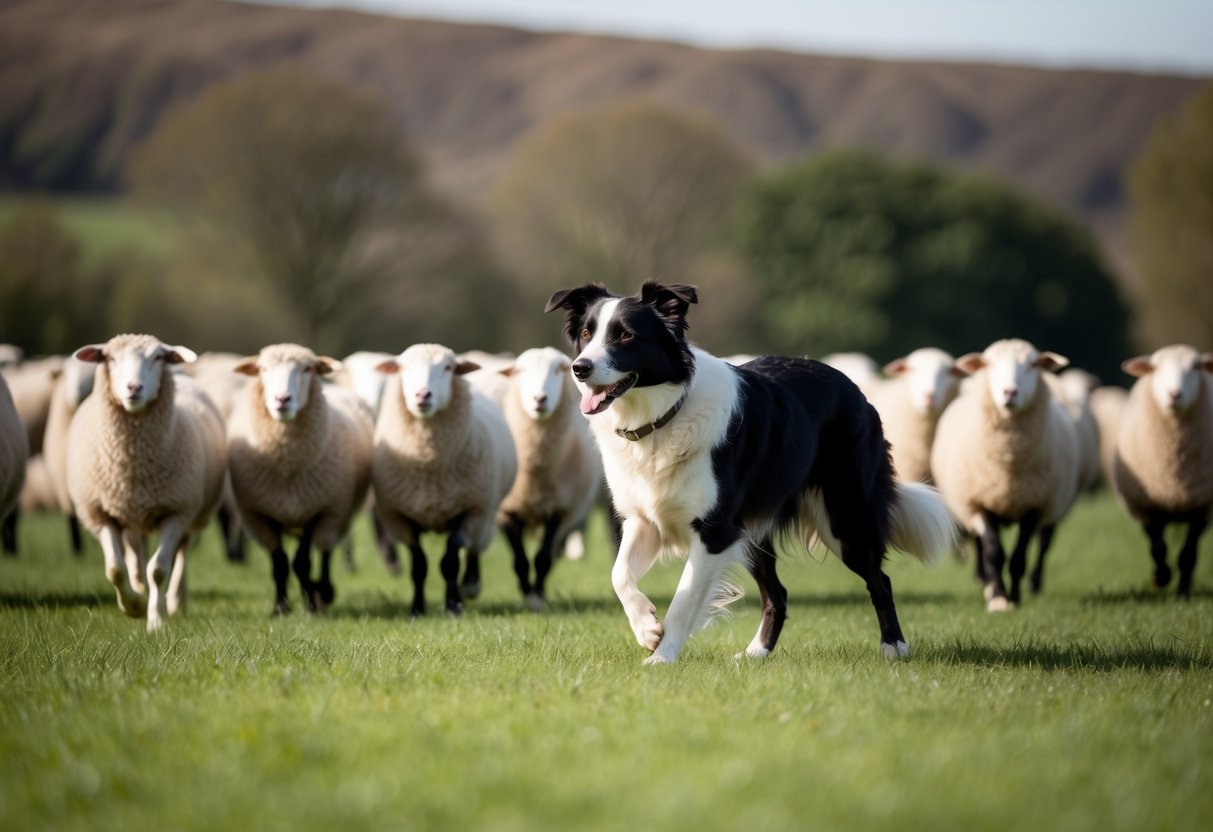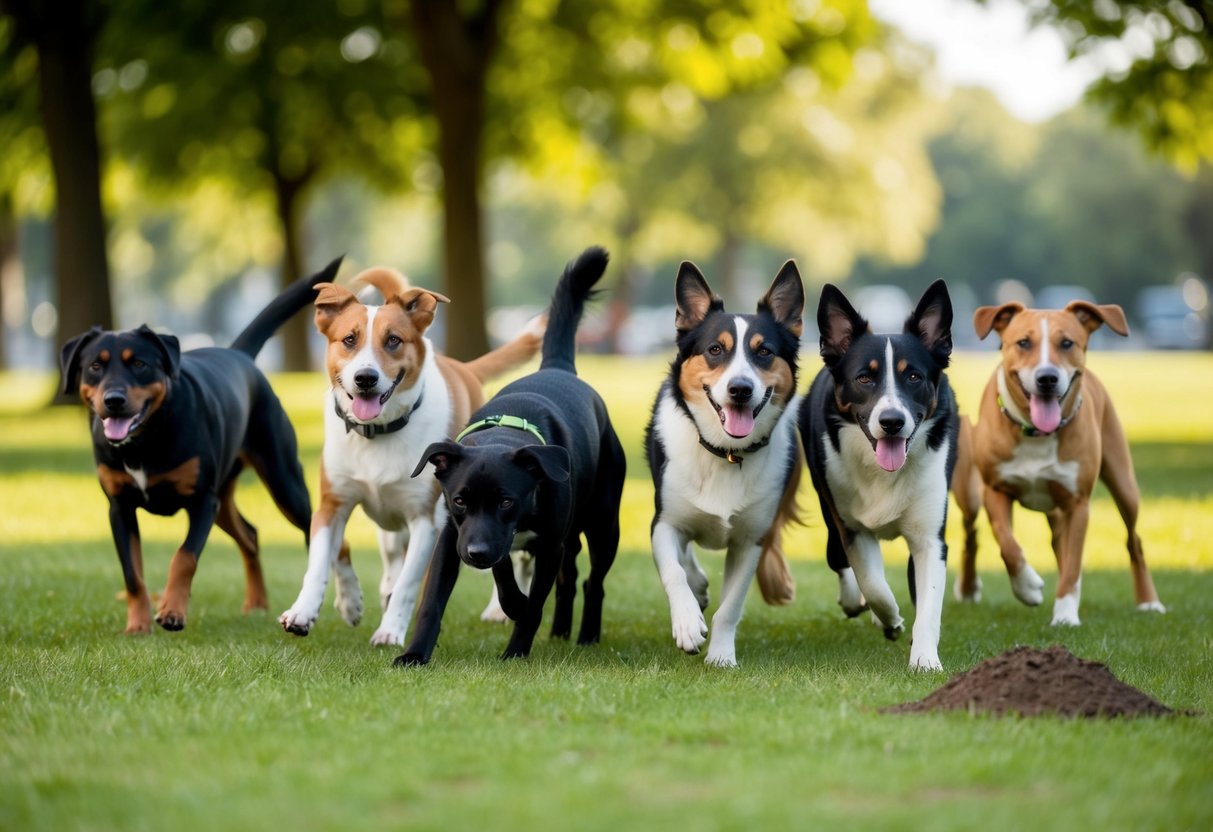LifeWithMyDogs is supported by our audience. When you purchase through one of our links, we may earn a small affiliate commission. As an Amazon Associate I earn from qualifying purchases. Your cost is not affected.
**********
Dogs show distinct behaviors based on their breeding history. These inherited traits explain why herding breeds like Border Collies naturally try to round up children, hunting breeds chase small animals, and guard dogs are protective of their families.
Different breeds have unique instincts that shaped their behaviors over many generations.
I’ve found that knowing why my dog acts certain ways helps me be a better pet parent. When I match activities to my dog’s natural drives, they’re happier and better behaved.
For example, giving a retriever swimming time or letting a terrier dig in a designated area lets them express normal breed behaviors safely.
Training works best when it fits a dog’s instincts. A beagle might need extra patience with recall training due to their strong nose-driven nature, while a German Shepherd often excels quickly at obedience due to their work-focused temperament.
Key Takeaways
- Each dog breed has specific behavioral traits tied to their original purpose
- Working with your dog’s natural instincts makes training easier and more effective
- Matching activities to breed-specific needs leads to a happier, well-behaved pet
The Importance of Recognizing Breed-Specific Behaviors
Breed-specific behaviors shape how our dogs interact with the world around them. These natural instincts influence everything from training success to daily activities.
Genetic Predispositions and Canine Behavior
I’ve learned that a dog’s genes play a huge role in their personality and actions. Different breeds have distinct behavioral traits that affect how they act and learn.
For example, Border Collies have strong herding instincts, while Beagles are driven by their powerful sense of smell. These traits come from their DNA.
When I work with dogs, I notice that breed-specific traits affect:
- Energy levels
- Prey drive
- Social behavior
- Training needs
- Exercise requirements
Historical Roles and Behavioral Impact
The jobs dogs were bred for still influence their behavior today. I’ve seen how understanding these original purposes helps predict and manage behavior.
Working breeds like German Shepherds often need mental challenges and physical jobs. They get bored without proper stimulation.
Hunting breeds like Retrievers naturally want to carry things in their mouths. This explains why many love playing fetch.
Guard dogs like Rottweilers tend to be more protective of their families. This comes from centuries of breeding for protection work.
Common Breed Categories and Their Instincts
Different dog breeds have unique instincts and behaviors that stem from their original breeding purposes. I’ve found that knowing these traits helps me better understand and care for dogs of various breeds.
Herding Breeds and Their Instincts
Herding breeds excel at tasks requiring focus and display strong working abilities. Border Collies, Australian Shepherds, and German Shepherds belong to this group.
These dogs often show:
- Circling and gathering behavior
- High energy levels
- Strong eye contact
- Natural tendency to control movement
I’ve noticed these breeds need plenty of mental stimulation. They love games that let them use their natural herding skills, like fetch and agility training.
Guarding Breeds and Their Protective Nature
Protective instincts run deep in guardian breeds, making them excellent watchdogs. Rottweilers, German Shepherds, and Bullmastiffs fall into this category.
Key traits include:
- Strong territorial instincts
- Natural alertness
- Deep loyalty to family
- Calm and confident demeanor
These dogs need early socialization. I’ve learned that proper training helps them distinguish between real threats and normal situations.
Hunting Breeds and Prey Drive
Hunting breeds were developed to help humans track and catch game. This group includes Retrievers, Pointers, and Beagles.
Common behaviors I see in hunting breeds:
- Strong prey drive
- Excellent nose work
- High stamina
- Natural retrieving instincts
These dogs excel at scent games and retrieving activities. I find they need regular exercise to manage their energy levels and satisfy their hunting instincts.
Companion Breeds and Their Desire for Affection
Companion breeds focus on human connection and affection. Breeds like Cavalier King Charles Spaniels, Pugs, and Maltese fit this category.
These breeds typically show:
- Strong bonds with humans
- Adaptability to apartment living
- Lower exercise needs
- Social nature
I’ve found these dogs thrive on human interaction. They make great therapy dogs and family pets because of their natural desire to connect with people.
Recognizing and Meeting Your Dog’s Exercise Needs
Different dog breeds need specific types of physical and mental activities to stay happy and healthy. I’ve found that matching exercise to breed traits helps prevent boredom and unwanted behaviors.
Physical Exercise for an Overall Well-Being
High-energy breeds like Border Collies and Australian Shepherds need 1-2 hours of intense exercise daily. I recommend activities that match their natural instincts.
For breeds with a strong prey drive, I suggest these activities:
- Fetch games with balls or frisbees
- Agility training courses
- Swimming (for water-loving breeds)
- Structured walking or jogging
I always monitor my dog’s energy level during exercise. Some breeds tire quickly, while others can go for hours.
Mental Stimulation to Reduce Unwanted Behaviors
Mental exercise is just as important as physical activity. I use these brain games to keep my dog engaged:
- Food puzzles and treat-dispensing toys
- Hide-and-seek with favorite toys
- Basic obedience training sessions
- Scent work activities
I’ve noticed that 15-20 minutes of mental exercise can tire out my dog as much as an hour of physical play. For working breeds, I combine mental tasks with physical exercise through activities like herding balls or tracking games.
Effective Training Strategies for Different Breeds
Different dog breeds need unique training approaches based on their natural instincts and traits. I’ve found that tailoring training methods to each breed leads to better results and happier dogs.
Positive Reinforcement Training Techniques
I always start with treats and praise that match each breed’s motivation level. High-energy breeds like Border Collies respond well to toys as rewards, while food-driven breeds like Labradors love treat-based training.
Small training sessions work best – just 5-10 minutes for easily distracted breeds and up to 20 minutes for focused ones.
Training cues to try:
- Verbal commands – Keep them short and consistent
- Hand signals – Great for herding breeds
- Clicker training – Perfect for smart breeds like Poodles
Addressing Behavioral Issues with Breed-Specific Training
I’ve learned that understanding breed-specific behaviors helps solve common problems. Terriers need extra work on impulse control for their digging habits.
Hunting breeds benefit from “leave it” and recall training to manage their prey drive. I use games that satisfy their natural instincts in a controlled way.
For guard breeds, I focus on controlled greetings and proper socialization to prevent overprotective behavior.
The Role of Socialization and Early Development
I make sure puppies meet different people, animals, and situations during their critical development period (3-16 weeks). Each breed has unique socialization needs.
Working breeds need exposure to various environments and surfaces. I introduce them to different sounds and experiences gradually.
Social breeds like Golden Retrievers thrive with plenty of dog-dog interactions, while independent breeds might need more one-on-one human time.
Key socialization activities:
- Puppy classes
- Controlled playdates
- Environmental exposure
- Handling exercises
Understanding and Embracing Natural Instincts
Dogs have amazing built-in behaviors that shape how they interact with the world. I’ve learned that working with these instincts instead of against them makes training much more successful and fun.
Herding Instincts in Action
Herding breeds excel at tasks that tap into their natural drive to gather and control movement. I’ve seen Border Collies and Australian Shepherds use their intense focus and quick reactions to keep groups together.
These dogs love having a job to do. I recommend channeling their herding energy into positive activities like:
- Agility courses
- Frisbee games
- Rally obedience
- Structured fetch games
A bored herding dog might try to herd children or other pets. I give them plenty of mental and physical exercise to prevent unwanted herding behaviors.
The Thrill of the Chase: High Prey Drive Dogs
Dogs with strong hunting instincts need appropriate outlets for their natural drive to chase. Breeds like Beagles, Terriers and Huskies have an incredible nose and love to track moving objects.
I redirect their prey drive into fun games:
- Flirt poles with toy attachments
- Scent work activities
- Lure coursing
- Hide and seek with toys
Training a solid “leave it” command is essential. This helps me keep control during walks when they spot squirrels or other small animals.
Guarding Behaviors and Territory Management
Many breeds have protective instincts meant to keep their family and space safe. I work with these natural behaviors rather than trying to eliminate them completely.
Smart management includes:
- Setting clear boundaries for acceptable alert barking
- Teaching a “quiet” command
- Proper socialization to prevent fearful reactions
- Structured greetings
I make sure to reward calm behavior around territory boundaries like fences and doorways. This helps my dog understand when guarding responses are needed versus when they can relax.
Lifestyle Adaptation: Choosing the Right Breed for You
I know that finding the perfect dog means matching their natural behaviors and needs with your daily routine and home environment. The right match creates a happy life for both you and your furry friend.
Breed Compatibility with Owner’s Lifestyle
When I look for the right dog breed, I first think about my activity level.
Active breeds need owners who can match their energy. A Border Collie or Australian Shepherd will need lots of exercise and mental stimulation.
If I work long hours, I avoid breeds prone to separation anxiety. Some breeds like Labrador Retrievers and Golden Retrievers adapt well to different schedules.
Living space matters too. I wouldn’t keep a large, energetic breed in a small apartment. Smaller breeds like Pugs or French Bulldogs can thrive in cozy spaces.
Considering Breed-Specific Needs for Companionship
Different breeds have varying social needs. Some dogs want to be my constant shadow, while others are more independent.
High Social Needs:
- Cavalier King Charles Spaniels
- Bichon Frises
- Golden Retrievers
More Independent Breeds:
- Chow Chows
- Shar Peis
- Afghan Hounds
I make sure I can give enough attention to social breeds. A Velcro dog like a Vizsla needs lots of interaction, while a Basenji might be happy with less constant companionship.
Available time for training also shapes my choice. Some breeds need more consistent training and mental exercise to stay happy.
Specialized Activities and Dog Sports
Different dog breeds excel at specific activities based on their natural skills and drives. These skills can be channeled into fun sports and structured training that keep dogs mentally and physically fit.
Canine Competitions: Showcasing Breed Talents
I’ve seen how breed-specific traits impact success in dog sports. Guardian breeds often shine in protection sports, while herding dogs dominate agility competitions.
Popular breed-specific competitions include:
- Herding trials for Border Collies and Australian Shepherds
- Lure coursing for sighthounds
- Weight pulling for strong breeds like Huskies
- Dock diving for water-loving retrievers
These activities let dogs use their natural talents while building our bond together.
Structured Play and Training for Skill Development
I’ve found that incorporating breed-specific behaviors into training makes learning more fun and effective.
For example, I use fetch games with retrievers and scent work with hunting breeds.
Regular training sessions should include:
- Physical exercise matched to your dog’s energy level
- Mental challenges that tap into natural instincts
- Structured play that reinforces good behaviors
I make sure to adapt activities based on my dog’s breed traits. This helps create engaging training that keeps them happy and well-behaved.
Navigating Common Breed-Specific Challenges
I know breed-specific behaviors can be tough to handle, but with the right approach we can turn these natural instincts into positive experiences. Let me share some tested solutions I’ve found for the most common challenges.
Excessive Barking and How to Mitigate It
Different breeds bark for different reasons. Herding breeds tend to bark more as part of their natural instinct to control movement.
I recommend starting with identifying your dog’s barking triggers. Is it people walking by? Other dogs? Or just general excitement?
Here are my top tips for managing excessive barking:
- Use positive reinforcement to reward quiet behavior
- Teach the “quiet” command using treats
- Provide plenty of mental stimulation through puzzle toys
- Create a consistent daily routine
Scent Tracking and Managing Hunting Instincts
Some breeds like Beagles and Bloodhounds have incredibly strong hunting instincts. I’ve found that trying to suppress these natural behaviors rarely works – it’s better to channel them positively.
Try these activities to satisfy hunting drives:
- Nose work games using hidden treats
- Scent tracking courses in secure areas
- Food puzzle toys that engage natural foraging instincts
Always keep these breeds on a leash in unsecured areas. I’ve seen even well-trained dogs bolt after interesting scents.
Coping with Separation Anxiety in Companion Breeds
Companion breeds often struggle with being alone, but I’ve found several effective strategies to help.
Start with short absences and gradually increase duration. I recommend recording your dog to understand their anxiety level when alone.
These tools have helped my clients tremendously:
- Calming music or TV background noise
- Interactive toys filled with frozen treats
- A consistent goodbye routine
- Crate training when done properly
- Exercise before leaving them alone
Consider using a pet camera to monitor progress and adjust your approach as needed.
Deep Dive into Specific Breed Behaviors
Different dog breeds show unique behaviors and traits that come from their original jobs. These breed-specific behaviors help me better understand what makes each type of dog special.
The Energetic and Intelligent Border Collie
Border Collies are among the smartest dogs I’ve seen. Their herding instincts show up in interesting ways – they might try to herd children, other pets, or even moving cars.
These dogs need lots of mental and physical exercise. I find that puzzle toys and agility training work great for them.
Key traits of Border Collies:
- Extremely high energy levels
- Superior problem-solving skills
- Strong eye contact and stalking behavior
- Intense focus on tasks
The Independent and Strong-Willed Terrier
Terriers bring spunk and determination to everything they do. I’ve noticed they love to dig, chase, and investigate their surroundings.
These brave little dogs were bred to hunt vermin, which explains their quick movements and fierce personalities. They often show their independent nature by making their own decisions.
Common terrier behaviors:
- Enthusiastic diggers
- Alert barkers
- Natural hunters
- Self-motivated workers
The Affectionate and Loyal Labrador Retriever
Labs make wonderful family pets because of their gentle nature. Their natural retrieving instincts make them excel at fetch games and water activities.
I love how Labs form strong bonds with their families. They’re usually great with kids and other pets.
Lab characteristics:
- Food motivated
- Eager to please
- Excellent swimmers
- Patient with children
The Curious Nature of Beagles and Hounds
Beagles and other hounds follow their noses everywhere! Their incredible sense of smell guides most of their behaviors.
These dogs were bred to track scents, which explains why they might ignore calls when they’re following an interesting smell.
Important hound traits:
- Powerful sense of smell
- Melodious barking and baying
- Pack-oriented behavior
- Strong tracking instincts
Frequently Asked Questions
Dogs show fascinating natural behaviors that come from their wolf ancestors and specialized breeding. These instincts shape how dogs act, play, and interact with their human families.
What natural instincts are common among most dogs?
Natural dog behaviors like digging, chasing, and marking territory come from their wild ancestors. These instincts helped them survive in the wild.
Dogs naturally want to live in groups and follow a leader. This pack mentality makes them great family pets who look to us for guidance.
How do a dog’s instincts vary by breed?
Different breeds have unique traits based on what they were bred to do. Herding dogs like Border Collies naturally want to round up moving objects.
Hunting breeds like Beagles have strong tracking instincts. Retrievers naturally want to carry things in their mouths.
Can you train a dog to overcome certain natural instincts?
I can redirect natural behaviors into positive activities. For example, I give digging dogs a designated sandbox area.
Training works best when I work with the dog’s natural tendencies instead of against them. A herding dog might enjoy agility training.
How do natural instincts dictate a dog’s behavior?
Breed-specific behaviors guide how dogs react to their environment. A guard dog may be more alert to sounds and movement.
These instincts affect how dogs play, explore, and interact with people and other animals.
In what ways do domesticated dogs exhibit their ancestral instincts?
Dogs circle before lying down just like wolves making a nest. They also hide toys and food like wolves cache their supplies.
Many dogs chase small animals or dig holes – behaviors passed down from their wolf ancestors.
Are some natural instincts more prevalent in certain dog breeds?
Specific breeds show stronger instincts based on their original jobs.
Terriers have a strong drive to chase and catch small prey. Meanwhile, livestock guardian breeds like Great Pyrenees are naturally protective and independent. Lastly, water dogs like Labs love swimming.













